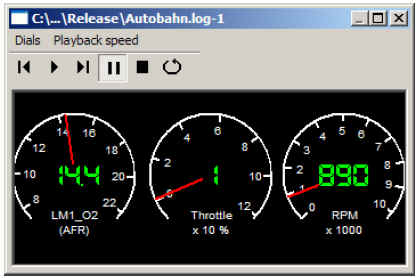Chassis dynamometers have been readily available for
several years in the performance motorcycling world. The use of a inertial
dynamometer has been the “gold” standard for tuning a performance
motorcycle since the early-90s. While few of the early chassis dyno’s
had the ability to monitor air fuel ratios (AFR), it really wasn’t
required to do a good performance tune on a carburetor bike. Just keep
changing main jets until the engine produced the most horsepower. Take the
bike out for a quick test ride and make a minor adjustment or two too the
jetting, then the rider goes home happy with a well tuned bike.
The emergence of fuel injected motorcycles in the
late 90’s required a different standard of tuning than a carburetor. It
was easy to set the wide open throttle fuel map on the chassis dyno using
similar techniques to doing a carburetor, but the partial throttle fuel
maps were a different story. A dyno operator could spend a lot of time
accelerating the engine through various RPM ranges and trying to watch the
tachometer and listen for engine misses, then make changes to the fuel
map. But this method is very hit and miss for setting a fuel injection
systems that run based on very exacting fuel maps.
The latest technology in dynamometer’s has added an
air fuel monitor and placed a load cell on the roller to simulate road
conditions. All of this can be purchased for just under $30,000. Now you
are ready to tune EFI motorcycles. Or at least you might understand why
your dyno guy is charging $60-$100 an hour for tuning time. They have a
lot of very expensive equipment to pay for.
You would think there is an easier and less expensive
way to properly tune fuel injected engines after you have made the
performance upgrades that you want to your bike. Something that a small
independent shop owner, serious racer or home tuner could use to help them
tune their fuel injected or carburetor bikes.
|
The Oxygen Sensor (also known as
Lambda Sensor) is located in the exhaust manifold and measures the
amount of unburned oxygen in your engine's exhaust. Based on the
amount of oxygen, it sends a signal to your engine computer which
then adjusts the air/fuel mixture for optimum engine performance
and emission control.
 |
Here at Nightrider.com we believe that there is a better and less expensive
way for those people who don't have a lot of money to invest in expensive
equipment. Over the past couple of years, there has been significant
advances in automotive electronics that has resulted in smaller size,
lower cost and expanding capabilities for monitoring engine functions.
Like it or not, a lot of this technology probably owes its existence to
government mandated pollution control laws. These laws forced the
automotive companies to invest research and development dollars into
sophisticated components to monitor and control engines. The same devices
that make sure an engine does not pollute the air can also help tune an
engine for maximum power. One of the most useful devices developed is the
Oxygen Sensor.
The only problem with Oxygen sensor for performance
tuning is the fact that they come in two basic varieties. The simpler
narrow band O2 sensor is really only accurate in the 14.2 to 15.2 air fuel
range. This is fine for pollution controlled vehicles, but basically
useless for performance work. Despite this, many performance enthusiasts
have tried to tune with one of the multitude of inexpensive AFR
gauges available for under $150. Few of them realized that the information
it gave them was almost useless and they could have done just as much
tuning work with a $30 narrow band O2 sensor with an equally inexpensive
Radio Shack voltmeter. The more accurate wide band O2 sensors is required
for tuning a performance engine. For many years, the O2 sensor alone might
cost you $150 or more. And the sensor required several hundred dollars
more in support electronics to be able to determine what the AFR really
was. These were very accurate, but very expensive.
|

Sample Logworks real time display
|
All of that has now changed. Innovate Technology’s LM-1 portable wide band
oxygen sensor gauge has been on the market for a couple of years now. Its
small size, accuracy, simplicity and low price have made it a popular tool
with the automobile performance crowd since its introduction. It has the
ability to data log engine and vehicle operating parameters such as air
fuel ratio, engine RPMs, throttle position sensor, vehicle MPH, EGT, CHT,
acceleration in G's, and virtually any sensor you could possible have on
your vehicle. Its logging ability, display capability and extensive list of add-ons make the LM-1 a very capable
tool for performance monitoring, and tuning on the street or the track. The
LM-1 includes Logworks software that has the ability to display AFR (air
fuel ratio) charts that can be
used to update your EFI fuel maps and create very accurate tuning.
Surprisingly, this very useful little performance tool has not caught on
with the two-wheeled crowd to the same extent as it has with
four-wheelers. Nightrider.com tested the
basic capabilities of Innovate Motorsports LM-1 in May, 2007 and found
it a very capable, precision instrument for any tuning requirements you
may have.
Nightrider now offers the LM-1 for sale though its Performance
Products web site. We can offer you your own LM-1
How Does tuning with AFR's help me?
Glad you asked that question. In order to
minimize gas emissions, produce maximum horsepower, get good gas mileage
or simply have good throttle response requires some very specific air fuel
ratio ranges.